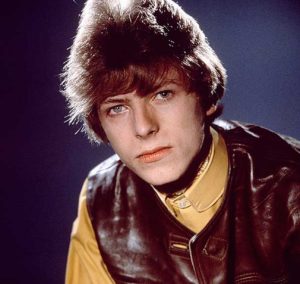As was the case with many artists of the 1970s, David Bowie was introduced to me via my older sister. Janet brought home Hunky Dory at some point late in the Nixon Administration and when she wasn’t playing it to death, I played it to death. In truth I hardly ever bothered with Side 2 because that’s how my primitive musical mind operated at the time. Side 1 had everything I thought I needed: the radio song, “Changes”; a screamer that Janet and I used to goof on together during car trips (“Oh, You Pretty Things”); and my favorite track, the always haunting and beautiful “Life on Mars”. Once I got to college and lived in close quarters with a more fully developed Bowie enthusiast/savant, Dennis Carboni, I would learn that Side 2 wasn’t just superb (“Song for Bob Dylan”, “Andy Warhol”) but indicative of Bowie’s new genre-busting album and persona to come (“Queen Bitch”).
[I wouldn’t dream of posting anything regarding Bowie without Dennis’ input. His annotative comments appear below, bolded and bracketed.]
It’s been more than a year since Dennis and I spoke of this and many other things the Tuesday following Bowie’s death, in January 2016. He confirmed what I remember us discussing all those years ago, in the wee hours, confined only by the sterile cinderblock walls of our codependent dorm lives — namely, that Bowie wasn’t just consistently 2-3 years ahead of every other rock ‘n’ roll artist in terms of musical direction and fashion sense; he normally hinted at his next departure on the back end (Side 2) of his previous album.
[I like how you wrote, “Dennis and I spoke of this and many other things,” which recalls the lyric, We passed upon the stair, we spoke of was and when — from “The Man Who Sold The World.”]
On the generally ethereal Hunky Dory, that clue was, of course, the propulsive and utterly sublime “Queen Bitch”, which heralded the coming of Ziggy Stardust and the Spiders from Mars, one of the great, pure rock (and proto-punk) albums of the decade. To say that Ziggy himself was one of the great “roles” played by any rocker of the period is not necessary, for no one else even attempted this sort of serial shape-shifting back then. Bowie turned this trick 4-5 times throughout the decade (hippie folkster to Ziggy to glam rocker to blue-eyed soul man to Thin White Duke) and competed in this regard only with himself.

Bowie’s career didn’t begin with Space Oddity in 1969. He’d been around since 1965, when this shot was taken. Pretty mainstream, for the time, and a reminder that these icons we associate with a particular decade didn’t arrive fully formed from the brow of Zeus.
[I’ve been reading the blog, “Pushing Ahead of the Dame.” You may know it, but check it out if you don’t. It’s fascinating. Yes, “Queen Bitch” is perfect because it starts with the acoustic guitar C-G-F progression à la Hunky Dory, then switches right to an electric C-G-F à la Ziggy.]
My sister didn’t own the Ziggy album; indeed, while I knew several cuts well (from FM radio play) I wouldn’t fully absorb it until the early 1980s. She did, however, possess one more Bowie LP: David Live, Bowie’s first official concert release where, once again, he shows us a transition in the making: from the hard-edged glam of Diamond Dogs to the Philly soul of Young Americans. I am not ashamed to admit that I love this particular Bowie period, this dalliance in what he later, somewhat ambivalently referred to as “plastic soul”. It does shame me to admit, however, that until I was 12-13 years old, I thought this dude’s name was David Live. Indeed, he looked and sounded so different from the Hunky Dory-era Bowie, I thought they were two different artists.

